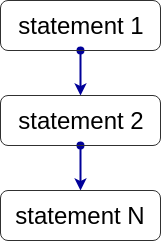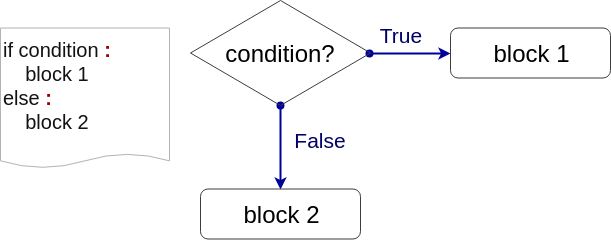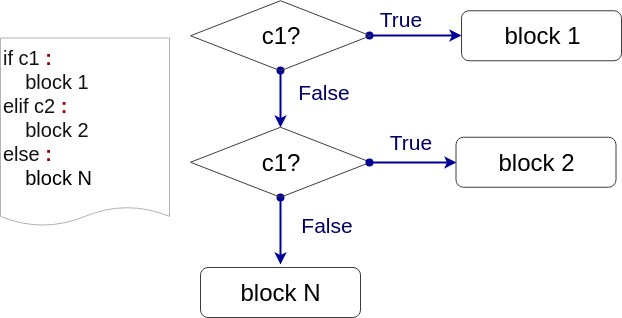Logical Expressions and Conditional Statements
Created for
Boolean type
What?
- Most programming languages define a Boolean type, which represents the truth values of logic and Boolean algebra (named after George Boole).
- Boolean values in Python are used mainly in the Conditional Statements and Logical Operations.
The Boolean type
- The Boolean data type consists of only 2 values:
- True
- False
- Note, that these are not variables names, but values like 0 and 1!
>>> print( type(True) )
<class 'bool'>
>>> print( type(False) )
<class 'bool'>
What is True/False in Python?
True/False values for most of the build-in objects:
| Type: | =False | =True |
|---|---|---|
| any numeric type | 0 (zero) | everything else |
| string | "" | any non-empty string |
| sequences and collections | empty | any non empty |
What is True/False in Python - the bool() check
Using the object constructor bool(), we can convert any Python value to True or False
>>> bool(-42)
True
>>> bool(0)
False
>>> bool(0.00001)
True
>>> bool("ada")
True
>>> bool("")
False
Logical (Boolean) operators
| Operation | Result |
|---|---|
| x or y | if x is false, then y, else x |
| x and y | if x is false, then x, else y |
| not x | if x is false, then True, else False |
Examples
>>> True and False
False
>>> 0 and 1
0
>>> 0 or 1
1
>>> 1 or 0
1
>>> not 1
False
>>> not 0
True
Comparison operators
intro
- With Comparison Operations we can check if 2 or more values are equal or if a value is less than other, and so on.
- The result of a Comparison Operation is True/False
- Comparing objects of different types, except different numeric, will raise a TypeError in Python3! (Can not compare "apples" with "oranges")
>>> 2 < 1
False
>>> 2 < "1"
...
TypeError: '<' not supported between instances of 'int' and 'str
Notes on comparison - Python 2
- docs.python.org/2/ - Value comparisons:
"The operators <, >, ==, >=, <=, and != compare the values of two objects. The objects do not need to have the same type."
"The value of an object is a rather abstract notion in Python"
"The default behavior for equality comparison (== and !=) is based on the identity of the objects"
"The default order comparison (<, >, <=, and >=) gives a consistent but arbitrary order."
Notes on comparison - Python 2 - examples
>>> "2" == 2
# False
>>> "2" >= 2
True
>>> 2 >= "2"
False
>>> 99999 >= "2"
False
Notes on comparison - Python 3
- docs.python.org/2/ - Value comparisons:
- "The default behavior for equality comparison (== and !=) is based on the identity of the objects. Hence, equality comparison of instances with the same identity results in equality, and equality comparison of instances with different identities results in inequality"
- "A default order comparison (<, >, <=, and >=) is not provided; an attempt raises TypeError."
Notes on comparison - best practices
When you need a reliable comparison, make sure that you compare values from same type!
If you need, you can convert between built-in types by using some of the Python's Built-in Functions (some of them will be discussed in further themes).
For objects comparison you can implement rich comparison methods (will be discussed in OOP themes)
Notes on comparison - best practices - examples
print("2" == str(2))
# True
print(int("2") >= 2)
# True
print(99999 >= int("2"))
# True
the operators
| Operation | Meaning |
|---|---|
< |
strictly less than |
<= |
less than or equal |
> |
strictly greater than |
>= |
greater than or equal |
== |
equal |
!= |
not equal |
is |
object identity* |
is not |
negated object identity* |
Objects identity will be discussed in the OOP part of the course.
examples
>>> i = 5
>>> i < 5
False
>>> i <= 5
True
>>> 9 < 1000
True
>>> "9" < "1000"
False
Note, the last example: "9" < "1000", the result is False, because strings are compared lexicographically.
lexicographical comparison
- Symbols are compared by their position (codepoint) according to the character code table used.
- First the first two items are compared, and if they differ this determines the outcome of the comparison.If they are equal, the next two items are compared, and so on, until either sequence is exhausted.
So, why "9" < "1000" returns False?
If we use the ASCII Codes Table, we see that the ASCII code point for "9" is 57, and for "1" - 49.
So, Python compares 57 < 49 and as the result is False it returns False for the whole expression
You can get the Unicode code point for a one-character string using the built-in ord() function
Control Flow Statements
What?
- The Control Flow statements allows our program to react in one way, if some condition is True, or in another way, if it's False.
Normal Control Flow
Statements are executed one after another, as written in code.

if statement
Syntax

- Condition can be any expression, which could be evaluated to True/False
if condition :
block 1
In Python, to encompass the statements which forms a block, you do not need to put any braces, but each statement have to be indented with the same amount of spaces!
example
x = 42
if ( x % 2 == 0):
print("{} is an even number!".format(x))
example - align matters
if False :
print("Statement1")
print("Statement2")
print("Statement3")
- Statement1 and Statement2 forms a block, which will be executed, only if the condition is true. This is not the case in example above, that's why only Statement3 will be executed.
if - else statement
Syntax
if condition :
block 1
else :
block 2
Flow

example - even/odd number
x = 41
if (x % 2 == 0):
print("{} is an EVEN number!".format(x))
else:
print("{} is an ODD number!".format(x))
41 is an ODD number!
example - hello in BG
user_lang = "bg"
if user_lang == "bg":
print("Здравейте")
else:
print("Hello")
print("-" * 20)
Здравейте
--------------------
if - elif - else statement
Syntax
if c1 :
block 1
elif c2:
block 2
else:
block 3
- We can have more than one elif statement, as shown in next examples!
Flow

example - multinational hello
user_lang = "it"
if user_lang == "bg":
print("Здравейте")
elif user_lang == "it":
print("Ciao")
elif user_lang == "en":
print("Hello")
else:
print("I do not speak your language!")
print("-" * 20)
Exercises
odd_or_even.py
- Write a program, which will print out for any integer number if it is odd or even.
- Be careful with the zero!
The BMI by categories
- Refine the BMI program form the (last lab)
- Now, the output of your program should be the BMI category, corresponding to the BMI index
Guess the number game - the beginning
- Write a simple Python program, implementing the "Guess the number" game, following the rules:
- The program will "think" of a number using the
random module, as shown in code shown in next slide. - You have to implement now only the first user move:
- Prompt the user for his/her guess
- If the user guess is equal to the machine number => print out a congratulation message!
- If the user guess is less than the machine number => print out "your guess is less than my number. Try again!"
- If the user guess is greater than the machine number => print out "your guess is greater than my number. Try again!"
Guess the number game - the beggining
from random import randint
machine_number = randint(1,10)
print("machine_number={}".format(machine_number))
### your code goes bellow:
These slides are based on
customised version of
framework

